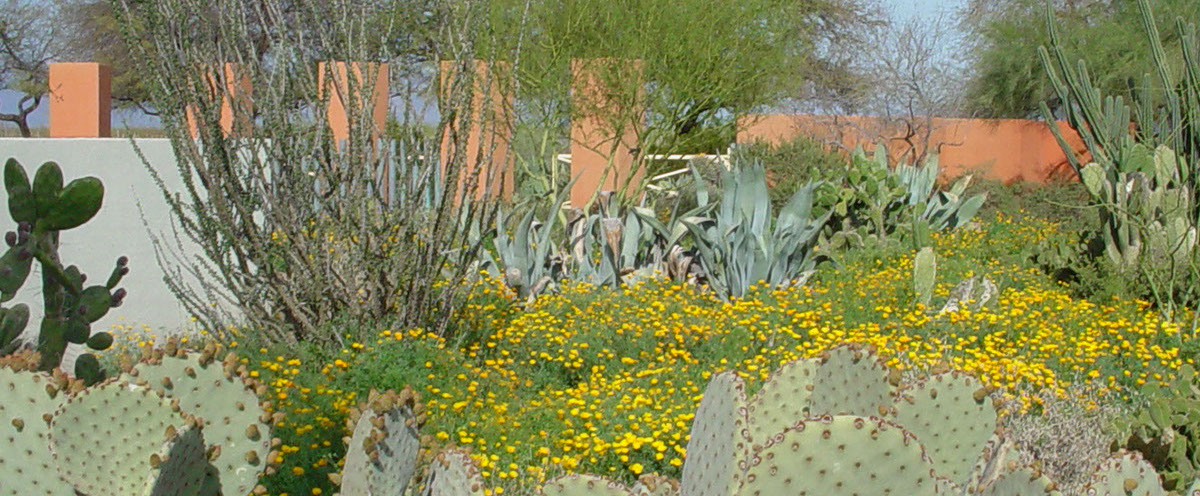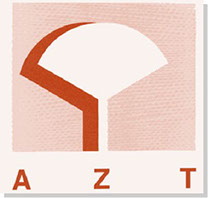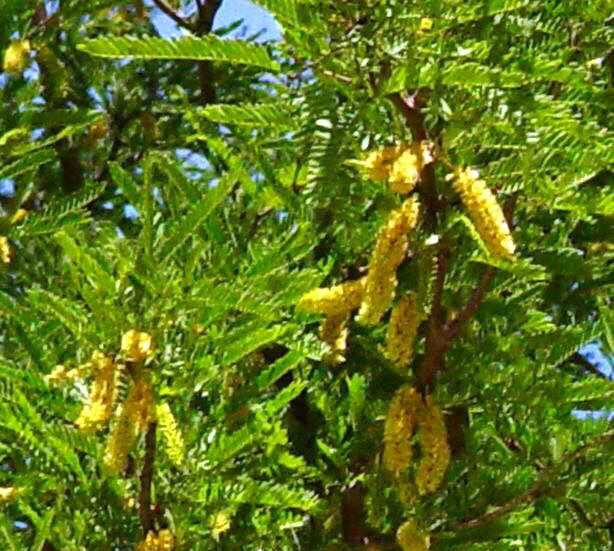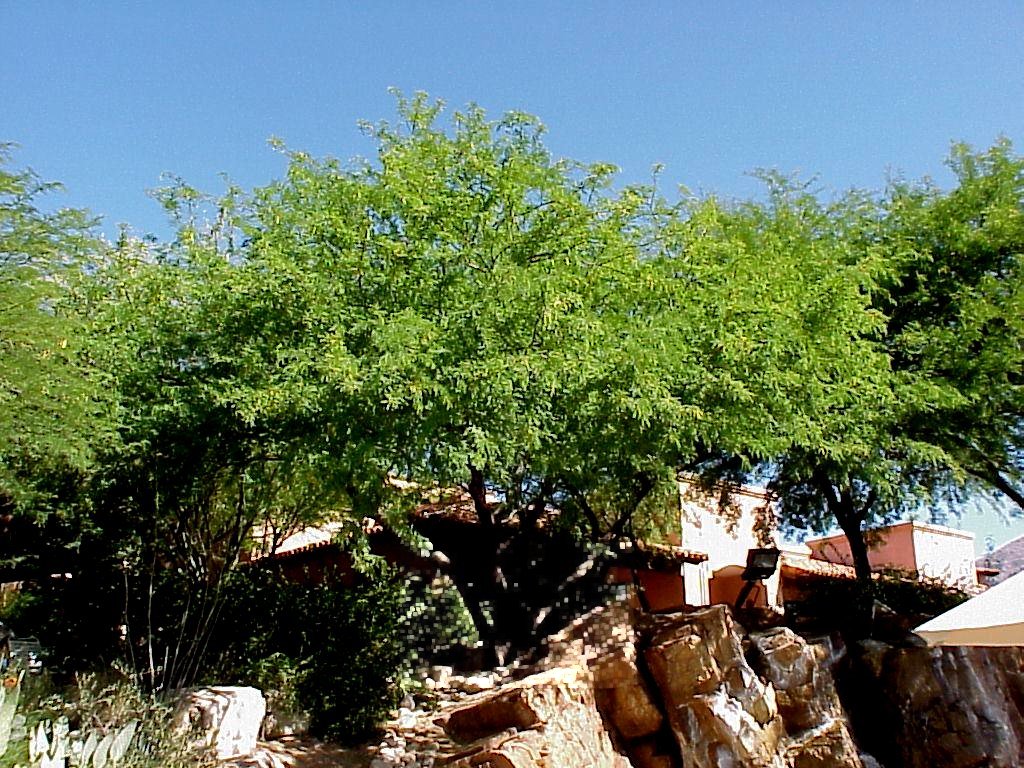


Prosopis thornless hybrid 'AZT'
'AZT' Thornless Hybrid Mesquite
Foliage: Semi-Deciduous
Mature Height: 20’ - 40’
Mature Width: 20’ - 40’
Growth Rate: Fast
Hardiness: 15 degrees F
Exposure: Full Sun
Leaf Color: Dark Green
Shade: Dense
Flower Color: Cream
Flower Shape: Fuzzy Spike
Flower Season: Late Spring
Thorns: None
Propagation Method: Cloning
Sizes Available: #25, #45, & 48"
Prosopis thornless hybrid 'AZT' PDF


Since their introduction in the 1950's, horticultural professionals have become accustomed to referring to Thornless Mesquites as Chilean Mesquite/ Prosopis chilensis or Argentine Mesquite/ Prosopis alba. The actual botanical name of this specie has long been a subject of controversy in both scientific and commercial circles. However, several points seem undisputed: 1) the published literature is nearly unanimous in describing the tree as a hybrid, a cross or mating of two different parent types; 2) trees sold are either entirely thornless or have few or very small thorns and 3) an assortment of trees with widely varying physical and horticultural characteristics, but sharing the thornless trait, are sold as Chilean Mesquites.
Within the landscape industry, Prosopis chilensis and Chilean Mesquites have evolved to become trade terms with only limited botanical relevance. The assortment of shapes and forms of thornless mesquites has been of benefit to landscape architects and contractors by offering them the opportunity to select trees uniquely suited to a given landscape application. The growing acceptance of arid landscape trees, mesquites included, has fostered a demand for greater uniformity but also great choice within desert landscape tree species.
Efforts to increase uniformity of thornless mesquites have emphasized either vegetative/clonal propagation (rooting a small portion of the plant) or "pure" seed culture, where growers work with seeds that produce trees highly similar to the parent stock. While both methods improve uniformity both have limitations. Both methods rely on limiting the genetic diversity within the propagation stock. Such limitation can be a double edged sword when trees are installed in the landscape. Genetic diversity serves to protect plant populations from devastating attacks by injurious insects and diseases. Selection of parent trees for seed or clonal propagation tends to focus on the phenotype or external features of trees. Upright branching, dense foliage, trunk structure and rapid growth are examples of phenotypes growers might use in selecting parent stock. Physical appearance alone gives little indication of rooting habit, cold hardiness, disease and insect resistance or adaptability to varying soil or growing conditions.
Prosopis Thornless Hybrid ‘AZT’, ‘AZT’ Thornless Hybrid Mesquite:
These trees exhibit a uniform appearance, upright growth and strong branch angles. Leaflets give the canopy a lush green look. The characteristics that set these ‘AZT’ clones apart from seed selections are the absence of thorns, uniform upright growth, synchronous bud break and, with sound horticultural practices, root mass growth that is in proportion to canopy growth.
Prosopis thornless hybrid 'AZT' is propagated and available exclusively from Arid Zone Trees.
Arid Zone Trees evaluates thousands of trees propagated from seed. Only individual trees having the most desirable physical qualities (branching habits, leaf color, leaf canopy, and flower color) and sound horticultural characteristics (rooting, cold hardiness and growth rate) are selected for further study. These trees are then cloned (vegetatively propagated) and planted at our demonstration garden for field evaluation and further assessment. The best of these trees are placed in our cloning production system and are designated Variety ‘AZT.’ Since no single selection of any desert tree species is best adapted to all landscape applications, we continually search for new additions to our Variety ‘AZT.’
While its horticultural characteristics and taxonomy remains the subject of sometimes heated discussion, Prosopis thornless hybrid ‘AZT’ are among the most popular and widely used trees in the desert landscape palette. It is not difficult to understand its popularity among landscape professionals given the trees’ qualities. Trees are thornless, making them ideal for landscape applications from re-vegetation of disturbed desert sites to streetscapes, park plantings and commercial and residential landscapes. The form and texture of Prosopis thornless hybrid ‘AZT’ blend almost seamlessly with surrounding native Sonoran desert trees and shrubs. They are used as theme trees along streets and commercial projects, as screens, wind breaks or barrier plantings, as transition trees back to native species in re-vegetation projects or any landscape applications where ample shade is desired. At maturity, Mesquites can be up to 30 feet tall and as wide with symmetrical, dome- shaped, spreading canopies. The foliage is lacy and fern-like with compound leaves consisting of anywhere from 20 to 40 leaflets. Cold hardy to 10 to 15 degrees F, they can be planted throughout most regions of the desert southwest.
Trees are semi-deciduous losing only a portion of their leaves in warmer winter locations. Leaves remaining through the winter are shed rapidly in spring just prior to bud break. In late spring Mesquites produce yellow-green, unremarkable, catkin-like flowers. By early summer curved and sometimes curled tan to brown seed pods mature and are shed.
The shade produced by Prosopis Thornless Hybrid ‘AZT’ can range from filtered to quite dense. Shade is a welcome addition to all desert landscapes but may inhibit the growth and flower production of under-story plantings. Carefully consider the ultimate shade that can be produced by these trees and the impact of shade on the growth and flowering of under-story plants and turf.
Prosopis Thornless Hybrid ‘AZT’ will tolerate an array of soil types and growing conditions from harsh, full sun to shady bosque or grove-like plantings. The first 2 to 3 years following transplanting are critical in establishing a well distributed root system. With supplemental irrigation and fertilization, Prosopis Thornless Hybrid ‘AZT’ grows at a moderate rate. Trees are most lush and exhibit best growth and appearance with irrigation during the hot, dry summer months. In landscape settings where water and nitrogen are unusually abundant, Mesquites can produce large dense leaf canopies from limited root systems. These trees will require more frequent pruning to reduce the risk of severe wind damage or uprooting often associated with the summer rainy season.
Prosopis thornless hybrid 'AZT' is propagated and available exclusively from Arid Zone Trees.
Cultural Practices:
Root Management and Irrigation
Wind damage and uprooting are the products of poor pruning and staking practices and improper irrigation and should not be considered as inherent, unavoidable horticultural shortcomings of Prosopis hybrids. A well distributed root system, essential for securely anchoring trees in the ground, is the product of good tree genetics, dynamic water application (that can be adjusted to respond to the growth and maturation of the trees) and an irrigation schedule (frequency) that is reflective of the site’s soil water penetration, water holding characteristics, and seasonality. Foster the development of a more dispersed root system and reduce the risk of wind throw by arranging irrigation emitters at varying distances from the trunk to encourage roots to "seek out" water and nutrients. Irrigation emitter arrangement along with other information on irrigations practices for desert trees can be found on our website FAQ page at “Irrigation Practices for Desert Trees.”
Pruning and Staking
Prune as needed to reinforce the structure and form of the tree. Regular, periodic thinning is the most desirable method of pruning. Pruning to remove about 20% of the canopy during the growing season helps promote root development that is proportional to the shoot growth of young trees. Removing more than 20% of the canopy can inhibit rooting, lead to sunburn injuries that can later be invaded by wood boring insects, and encourage undesired re-growth made up of dense flushes of branches and leaves. Selective pruning should be used to promote the development of a symmetrical canopy with well spaced branches. Avoid hedging or heading back desert species as this will only stimulate excessive branching. Use tree stakes only when absolutely necessary and then only briefly. Select multiple trunk or low-breaking, upright trees as they occupy no more space than a single-trunk specimen yet retain the natural wind resistance of trees found growing in native desert settings. Always use clean, sharp tools that are cleaned regularly in a 10% solution of bleach. For a detailed pruning guide visit our website FAQ page, see “Pruning Desert Trees.”
Pests
In rare instances, insect pests can be a problem on some desert trees. On young trees, insect infestation can slow typical seasonal growth. Inspect trees during the growing season for common garden sucking insects such as aphids, thrip, whiteflies or psyllids. During dry months, (May and June) in dusty conditions, spider mites can appear. Monitor for infestation and apply controls as needed. Spray applications of water or water and Safer Soap give short-term control (3 to 7 days) for small insect population. For heavy infestation or longer control, use federally registered insecticides. A contact insecticide application will kill existing adults. An application with a foliar applied systemic or soil drench applied systemic will provide 8 to 12 weeks control for any post application insect hatchings or migration of insects. Before using pesticide for the first time or on new plants or cultivar, treat a few plants and check for phytotoxicity. Always read the label and follow label instruction before using pesticides. For pesticide control recommendations contact a licensed pest control advisor.
‘Variety AZT’ is just one part of Arid Zone Trees’ commitment to providing quality products and professional services.

© Copyright 2000-2020 Arid Zone Trees